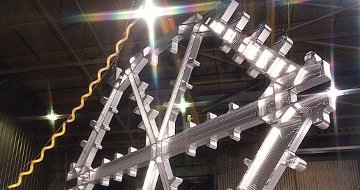Characteristics:
Aluminum is a silvery-white metal. It is non-magnetic and an excellent electrical conductor. It is of low density and high ductility. It is too reactive to be commonly found as the metal although, very rarely, the native metal can be found. (5)
Aluminum's appearance is dulled and its reactivity is passivated by a film of aluminum oxide that naturally forms on the surface of the metal under normal conditions. The oxide film results in a material that resists corrosion. The film can be thickened using electrolysis or oxidizing agents and aluminum in this form will resist attack by dilute acids, dilute alkalis and concentrated nitric acid.
Aluminum lies sufficiently far on the right side of the periodic table that it shows some hints of nonmetal behavior, reacting with hot alkalis to form aluminate ions [Al(OH)4]- as well as the more typical metal reaction with acids to release hydrogen gas and form the positively charged metal ion, Al3+. i.e. aluminum is amphoteric.
Pure aluminum is quite soft and lacking in strength. Aluminum used in commercial applications has small amounts of silicon and iron (less than 1%) added, resulting in greatly improved strength and hardness.
Uses:
As a result of its low density, low cost, and corrosion resistance, aluminum is widely used around the world.
It is used in an extensive range of products from drinks cans to window frames and boats to aircraft. A Boeing 747-400 contains 147,000 pounds (66,150 kg) of high-strength aluminum.
Unlike some metals, aluminum has no aroma - hence its widespread use in food packaging and cooking pots.
Although not quite as good as silver or copper, aluminum is an excellent electrical conductor. It is also considerably cheaper and lighter than these metals, so it is used widely in overhead power lines.
Of all the metals, only iron is used more widely than aluminum.
|
